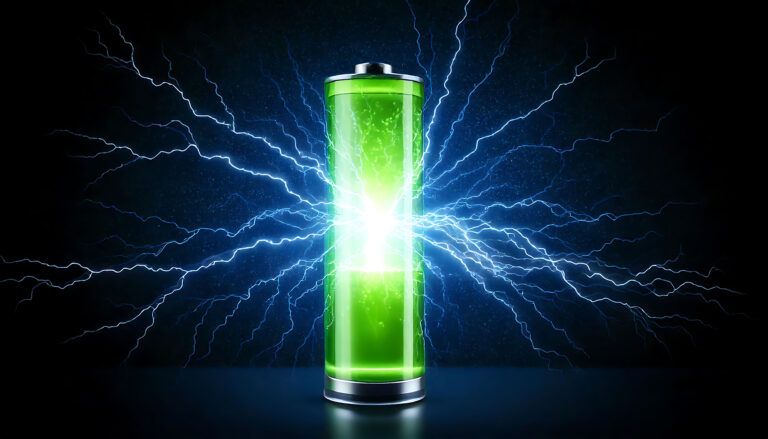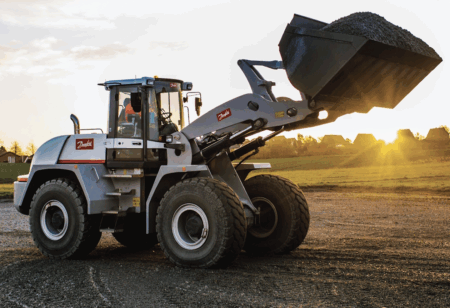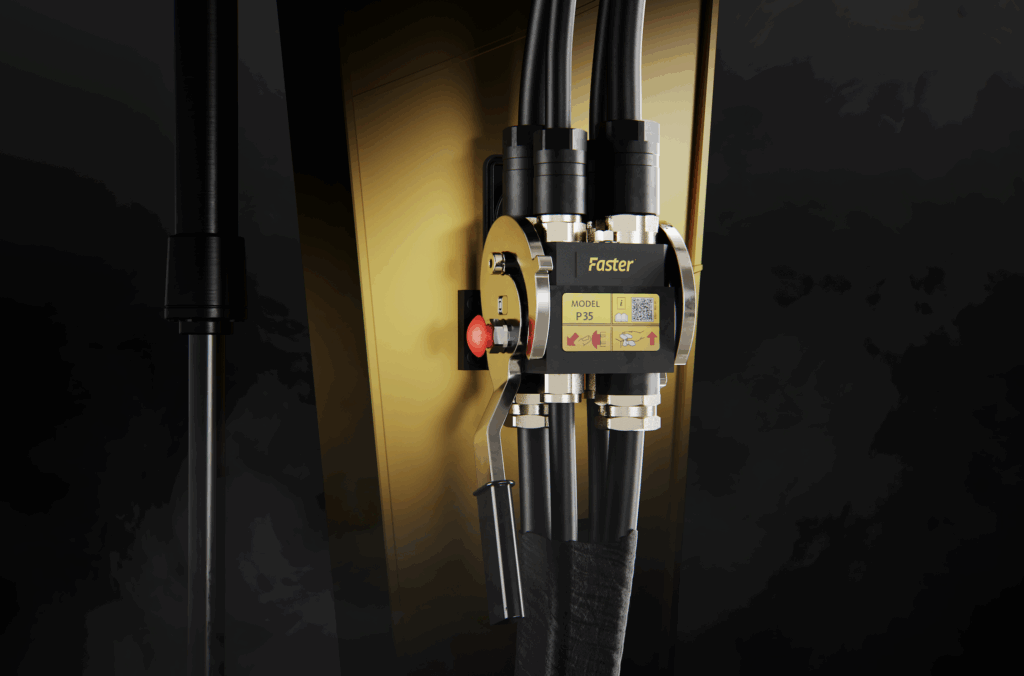Battery technology challenges and the solutions that are helping to power the next-generation of industrial vehicles
Unlike the automotive sector’s relatively straightforward transition to electric power, off-highway applications present challenges that demand innovative solutions and a rethinking of traditional approaches.
On power requirements alone the differences are stark – where automotive applications might require 50-100kWh of battery capacity, off-highway vehicles can demand 400kWh or more. Within off highway each application demands different solutions, different compromises, and different innovations – from construction sites where 40-tonne excavators operate for a whole working day, to warehouses where autonomous mobile robots and forklifts are used on rolling shifts.

Duty cycles compound the complexity of electrification. “You’ve got machines that work two to four hours during the day with the rest being idle hours, versus a haul truck that may run 24 hours a day with three or four operators,” says Dr Ray Gallant, vice president of sustainability and productivity services at Volvo Construction Equipment.
This variation creates what Gallant describes as a grid of applications, plotted against hours of use per day and power requirements. “The larger the machine, the more the power requirement. And smaller, compact machines generally see significantly shorter duty cycles during the day.”

For manufacturers, this means that there is no one-size-fits-all solution. Battery-only works well for smaller equipment with shorter duty cycles, but as power requirements increase beyond 300kWh and duty cycles extend to full shifts, other technologies come to the forefront – hybrid drives, alternate fuels, gridconnected machines, and even hydrogen fuel cells for the heaviest industrial applications.
Integrated battery solutions
In the material-handling sector, the switch has not just been from diesel to battery power, but also from lead-acid to lithium. This has prompted Crown Equipment to reimagine the relationship between vehicle, battery, and charger by delivering a fully integrated solution called V-Power.
Trevor Bonifas, general manager for motive power at Crown explains the reason for the new offering: “A lot of our customers have basically come to us and said ‘We’re tired of the finger pointing. The battery caused the truck to have a problem. The truck caused the battery to have a problem, or the charger now impacted all of it.’”
“We wanted to give a unique experience to our customers, where it was one service provider, so they could get the truck, the battery and the charger all from one company”
While lift-trucks have been running on lead-acid batteries for decades, the issue of battery compatibility was heightened by the advent of lithium chemistry. “Lead acid batteries are dumb,” says Bonifas. “You can trick them to work in anything, but with lithium batteries, there’s a brain on them. There’s a central control unit. And if the battery stops giving power to the truck, it’ll lock the brakes up.”
In response to the growing compatibility problems, Crown Equipment established its motive power division in 2020 to offer integrated solutions where truck, battery, and charger are fully integrated at the design stage. “We wanted to give our customers a unique experience where it was one service provider, so they could get the truck, the battery and the charger all from one company,” says Bonifas.

A collaborative trend
Other lift-truck vehicle manufacturers are sharing the Crown ethos and working ever-more closely with battery suppliers. John Barilleaux from Hubtex, which manufactures side loaders, describes the challenge: “In a lot of cases, companies will design AGVs (automated guided vehicles). Customers will spec an AGV that they want. They’ll work with a company to develop a product, and then they get all the way through the design cycle, and they realise they need a battery.”
“The battery inside the AGV is actually truly the heart and soul. Nothing works without a battery, and the battery has to communicate with the AGV or AMR (autonomous mobile robot), in order for the machine to operate and do the job that it needs to do.”
Robin Schneider from Green Cubes Technology, a lithium battery manufacturer, emphasises the importance of early collaboration: “Having cohesive communication between the AMR and AGV manufacturers and their development team and the battery manufacturer and their development team is really key to making sure that you have a successful implementation.”
“Having cohesive communication between OEMs and battery manufactures is really key to making sure that have a successful implementation”
Real-world performance
The theoretical benefits of electrification are now being validated by real-world data. Volvo’s trials in Southern California provide compelling evidence of the transformation’s potential. Running an EC230 Electric excavator for 122 hours, the company achieved dramatic results: “Carbon emissions into the atmosphere were down by anywhere between 65 and 80%,” says Gallant. This in turn translated into fuel savings of 82% comparing the cost of electricity with the cost of diesel.
But Gallant is careful to be realistic about the broader implications: “Electric machines have about 35% less repair and maintenance, but what about battery replacement? That is a very real consideration. The batteries do degrade. They do wear out.” But even accounting for complete battery replacement, Gallant still predicts savings of at least 6% on maintenance.
That said, Volvo’s estimates on battery life may be too conservative. Crown’s experience with AGV systems, running 48-volts, 200 amphour batteries in constant use since 2018, have exceeded expectations. “These were brought in during 2018. I took some measurements on these batteries a few weeks ago and the cells are still above 80% of what their original capacities were,” says Bonifas. “They’re an older cell technology, and they were initially only rated to do about 1,000 cycles. And I’m sure we’re well over that, probably in the 3,500 cycle range.”
Green Cubes’ data is also promising, as Schneider notes: “Lithium-ion batteries can increase productivity and lower the total cost of operation by about 30%. They are also about 98% efficient versus 80% efficient with a lead acid battery.”

Charging ahead
Crown’s V-Power system extends beyond vehicle technology to include charging systems and sophisticated power management to address one of electrification’s biggest challenges – grid demand. “We’re charging at such high rates and probably a little more frequently than we would have with lead acid, especially in those high-demand applications,” says Bonifas. “So we have developed products that can essentially shave the demand at certain times of the day, so we can basically control and lower electrical utility bills from a specific customer based on charging at certain times of the day.”
The system is predictive rather than reactive. “Each solution is a little bit different for every single customer. Instead of pulling 40kW, we’re going to limit them to 20kW, because they only need X amount of trucks running during that third shift or second shift.”
This intelligence extends to individual vehicle behaviour. For AGVs for example the constant power draw creates unique challenges. “Where a regular forklift will drop down to maybe less than an amp of current when idle, an AGV has got all the sensors always running. The IPC (instrument panel cluster) is always running. It’s always communicating with the server. So, in some cases, we’re drawing five to six amps of current just sitting idle.
Gallant agrees with the need for smart energy management as the key to developing more sustainable sites. “We can do a lot of things to improve the site and also to improve the workflow, but if we focus on energy management, we can get it to a sustainable point,” he says.
Green Cubes is also working on optimising charging, and has developed multi-voltage systems that can reduce charging time by an impressive 50%. “You charge at double the voltage and half the current, and then you discharge at double the current and half the voltage, so it’s constant power,” says Schneider.
The momentum within the industry suggests that current solutions represent just the beginning of what will be a longer transformation Bonifas at Crown anticipates fundamental industrial design changes: “As lithium batteries get more integrated into the truck, it’s going to be a smaller area where the battery is, which could lead to a complete redesign of how forklifts look. But it’s going to take a while for the parts, the aftermarket, and everything, to catch up to the new ways of doing things.”
“We view sustainability as basically a balance between three pillars – social, environmental and economic sustainability”
The ongoing transformation of the off-highway industry represents what Gallant calls a journey rather than a destination. “We view sustainability as basically a balance between three pillars – social, environmental and economic sustainability,” he says. “We have to keep these three pillars in balance.
“Faith in the future gives us power in the present. We have the right people that can solve this. We know how to do it. The technology is maturing and if we have the faith that we will be able to get there, we have the courage and the ability to take the steps that we need to do in the present to make it happen.”
Ray Gallant, John Barilleaux and Robin Schneider shared their insights during Zapi Group’s 2025 Future of Electrification Conference, a virtual event focused on innovation in industrial, commercial and utility vehicle electrification. www.zapigroup.com/en/
SUPPLIER SPOTLIGHT: ALIANT BATTERY
Aliant Battery, a division of Elsa Solutions, specialises in the design, production and development of lithium batteries for industrial vehicles and heavy duty applications. Aliant Battery storage solutions are tailored to customer needs, ensuring maximum interoperability between battery and machine and optimisation of performance.
The ability to produce fully customised batteries in a short time and maintaining high standards is the result of the know-how gained in the most complex and demanding industrial fields in terms of certifications and reliability of components, in addition to a vision oriented towards constant improvement, development and technological innovation.
The company boasts over 40 years of experience in the world of industrial power electronics and it continues to grow with the recent expansion of manufacturing capacity and the adoption of a cutting-edge robotic lithium battery production line, with the target for an annual production of over 200MWh.
Aliant Battery sees R&D as a fundamental pillar for the future: the introduction of new specialised figures and latest-generation design and simulation software, and the simultaneous development of advanced solutions demonstrate the company’s commitment to maintaining a technological advantage, such as the development of a solid-state battery.
SUPPLIER SPOTLIGHT: PROVENTIA
Proventia is a Finnish technology company committed to reducing emissions and improving energy efficiency in the non-road mobile machinery (NRMM) sector. It is strengthening its role in clean power innovation through its modular lithium-ion battery packs and electric powertrains for hybrid, fully electric, and fuel cell applications.

Proventia’s Energy Batteries, based on lithium iron phosphate (LFP) chemistry, offer high performance, long cycle life, and excellent thermal stability. These characteristics make them particularly suitable for heavy-duty full electric applications such as wheel loaders, excavators, and material handling equipment.
The batteries use cells from Norwegian Morrow Batteries, ensuring European quality and traceability. In addition, LFP chemistry brings key sustainability benefits. Free from cobalt and nickel, and featuring a lower carbon footprint, LFP technology supports OEM decarbonization goals.
Proventia’s Power Batteries utilize lithium titanate oxide (LTO) chemistry, providing exceptional safety, an even longer cycle life, stability in extreme conditions, and high C-rates, ideal for demanding non-road machinery peak shaving.
For seamless machine integration, Proventia’s Technology Centre supports simulation and control system development during design phase. Combined with the Test Centre for battery and hybrid system testing, Proventia offers a complete development environment for next-generation electric powertrains.
SUPPLIER SPOTLIGHT: FLASH BATTERY

Since 2012, Flash Battery has been designing and manufacturing customised lithium batteries for off-highway vehicle OEMs with medium production volumes and high tailoring requirements. Its strong focus on the industrial market has led to the development of custom-made battery solutions that meet space constraints and deliver the required voltages and power for each application.
A key technology from the manufacturer is the patented BMS, the Flash Balancing System, which provides high-power (20A) active and passive balancing during both charging and discharging. It actively supports weaker cells, ensures temperature control with two sensors per cell, enables zero maintenance, and guarantees short charging times, with a balancing time under 30 minutes.
Flash Battery’s lithium batteries are also connected to the Flash Data Centre: a cloud-based remote control system that uses AI and machine learning to analyse data from all active battery systems worldwide. The core feature is automatic data control: performance is monitored daily to detect and eliminate false reports and anomalies through predictive maintenance and over-the-air updates. Thanks to the Flash Data Centre, every battery can be monitored 24/7, malfunctions are instantly reported, and extraordinary maintenance is efficiently scheduled. This significantly eliminates maintenance costs, increases productivity, prevents anomalies, and predicts the battery’s future behaviour and end-of-life, making Flash Battery a leader in intelligent lithium battery systems.
SUPPLIER SPOTLGHT: ZAPI GROUP
As electrification transforms the off-highway sector, construction equipment OEMs require charging solutions specifically engineered for non-road mobile machinery (NRMM) applications. Mid-power charging requirements of 2-20kW machines require compact, rugged and reliable solutions exposed to demanding operational environments. Advanced 3.3kW solutions now deliver IP66/IP67-rated protection against dust and water while withstanding mechanical shock, impact, and vibration fatigue. Worksites typically employ both on-board chargers (featuring intuitive machine-user interfaces and full communication with vehicle master controllers) and portable off-board chargers that provide charging accessibility across remote worksites lacking charging infrastructure.
Zapi Group’s charging solutions, delivered through member companies Delta-Q Technologies and Zivan, cater highly integratable solutions to this dual approach while maintaining compatibility with diverse battery chemistries and communication protocols.
Developed through strategic OEM partnerships, rigorous testing and conformance to internationally recognized certifications, Zapi Group’s charging solutions help operators achieve maximum performance and low cost of ownership from electrification investments across international markets.
For off-highway professionals navigating the transition from combustion to electric powertrains, selecting providers with deep expertise and comprehensive technology portfolios proves essential for successful electrification strategies in this rapidly evolving sector.
SUPPLIER SPOTLIGHT: WATTALPS
Wattalps designs and manufactures high-performance lithium-ion batteries, using a patented immersion cooling technology. This technology makes it possible to further push the limits of classical li-ion batteries, by increasing their performance, their life and their safety.

In addition to outstanding thermal management efficiency, Wattalps immersion cooling technology provides a high level of passive safety against thermal runaway propagation.
Thanks to Wattalps’ BMS, with hardware and software designed in-house, Wattalps guarantees excellent functional safety certified according to ISO 26262 up to ASIL C. The dielectric fluid used for Wattalps’ batteries is biodegradable, non-toxic and non-flammable.
The modular design of the packs allows for a fast integration phase and very compact solutions with high energy density and extreme power output.
Wattalps’ solutions are available in three families, adapted to the specific applications of our customers, favouring either the extreme compactness of the High Energy packs, or the possibility of repeated fast charging for the Fast Charge and Life packs, or the ability to withstand very high current peaks for the Performance Power packs, which are particularly well suited to the hybridisation of vehicles.
Wattalps batteries, including connections, are natively IP67 / IP69K rated. Wattalps batteries are certified according to IEC62619 and ISO26262 ASIL B/C, and have passed all tests for R10, UN38.3 and R100rev.3.
This article first appeared in the August issue of iVT





